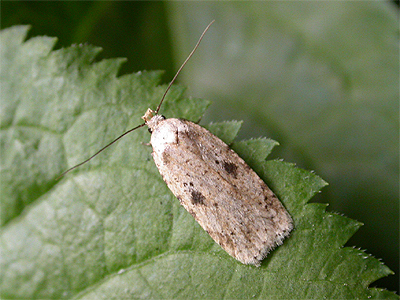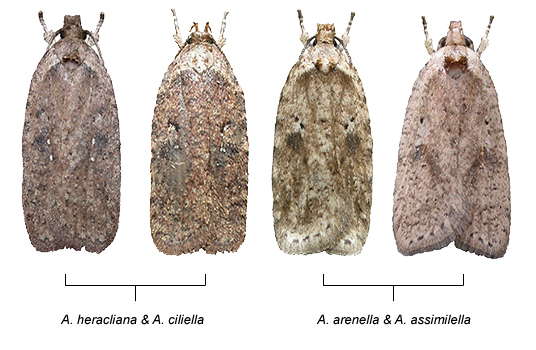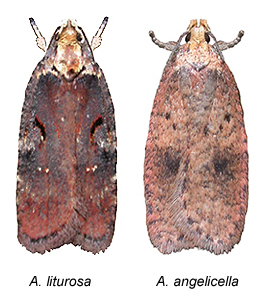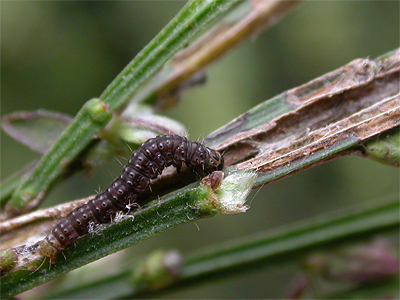

| Nottinghamshire's difficult Agonopterix |
| ............... |
 |
Moths of the Genus Agonopterix,
often get dismissed as unidentifiable 'little brown
jobs', due to the increasingly less used thought, that
most of our resident micro moths need dissection to
determine their species. Its a statement we keep mentioning, but is far from being completely true, as micro moths are becoming identified with more frequency. With this brief look at some tricky identification pairs, we hope to continue to encourage moth trappers to have a go and try to identify what species of micro moths they can. But please remember that there are other species which look very similar and that variability should also be taken into account. Experience helps towards a quicker identification, so it pays to get used to these moths. |
|
| ............... | ||
| Similar
species Before looking at the potential difficultes in separating similar species, its worth remembering that there are other moths which do look extremely 'Agonopterix like'. It is impossible to list them all here, so care should be taken before coming to any identification. A glance through any photos of Depressariidae or Gelechiidae for similar looking species is recommended and Parsnip Moth Depressaria radiella (Retzius, 1783) is one look-alike to be particularly aware of, but it is usually a slightly larger moth and once learnt, should be remembered. |
| ............... | ||
| Agonopterix
alstromeriana and Agonopterix occellana are
very alike, but relatively straight forward to tell
apart. Both moths have a rather scruffy, whitish ground
colour to the forewings and characteristic markings are
restricted to short, red streaks and black spots. In A. alstromeriana the short, red streak runs alongside the black discal spot, which continues to the edge of the forewing in a rather messy fashion. A. occellana is a more cleaner and neater looking moth. The black discal spot is small and well away from the forewing edge and the red streak is less obvious, as it runs around/through two single spots above the costal spot. Agonopterix nervosa and Agonopterix umbellana are likely to occur in open habitat where their respective foodplants grow and so both moths are perhaps less likely to occur in urban areas, than the others dealt with here. |
 |
|
| ............... | ||
| These can be two
difficult moths to tell apart, as the ground colouration
on the forewings of both species is usually a very light
sandy colour. The markings vary, but there is usually the
faintest hint of a red streak near the middle of the wing
in A. nervosa, with darker markings consisting
of a peppering of black spots. In A. umbellana,
the veins of the forewings are usually highlighted dark,
giving the moth a streaky appearance and the ground
colour has a cold feel to it than on A. nervosa. Without dissection of the genitalia, or by seeing the hindwings sufficiently well to count the number of dark lines in the hindwing cilia, Agonopterix heracliana and Agonopterix ciliella cannot be reliably told apart. |
| ............... | ||
| The forewings of both
are identically (if little) marked with two small,
pure white spots (often very slightly elongated) being
the most consistant feature on a dirty looking
greyish/brown ground colour. There are also a couple of blackish dots between the two white spots in the middle of the forewing and the base, which often merge to form a small crescent-like mark, but these can become lost through wear. Agonopterix arenella and Agonopterix assimilella are two similar moths and to make matter worse, there are others that can be equally variable and similar. We have found, that of the two, A. arenella is slightly heavier marked than A. assimilella. With age comes wear and tear, so many over-wintered specimens of A. arenella fade and become much paler. However, the darkish spot in the middle of the forewings remains quite an obvious feature. |
 |
|
| ............... | ||
| Recent
Nottinghamshire records and presumed county (VC56) status
At least 13 species of Agonopterix are known from Nottinghamshire, but we are only able to base the following summaries on the records we have at our disposal. The records are believed to be quite representative to give a good idea of species distribution and have been sent to us from a number of sources, including the Nottinghamshire Wildlife Trust and regular contributors of moth records to this website. 32.007 (B&F 701) Agonopterix occellana (Fabricius, 1775) The number of records we have, suggest that this moth is uncommon over most of Nottinghamshire, but it has been well recorded at the Idle Valley NR in recent years, suggesting that A. occellana is just under-recorded. 32.008 (B&F 709) Agonopterix liturosa (Haworth, 1811) Seems genuinely uncommon. All records we have are from the north of the county, being recorded from Misson Carr (Nottinghamshire Wildlife Trust), the Idle Valley NR (Lound Moth Group) and both Eaton and Gamston Woods (Pendleton, T.A. and Pendleton, D.T.). 32.009 (B&F 691) Agonopterix purpurea (Haworth, 1811) We believe this moth has occurred in Nottinghamshire, but have no definite records. 32.010 (B&F 710) Agonopterix conterminella (Zeller, 1839) Rare in Nottinghamshire with two recent records from VC56, both from Broadholme on the Nottinghamshire/Lincolnshire border in 2009 and 2014 (Gray, M.). Both specimens were determined by genitalia determination. 32.011 (B&F 704) Agonopterix scopariella (Heinemann, 1870) A rare/uncommon moth in Nottinghamshire with records from Rainworth Heath in October 2015 (Pendleton, T.A. and Pendleton, D.T.) and Warsop Main Pit Top in January 2019 (Pendleton, T.A. and Pendleton, D.T.). 32.015 (B&F 692) Agonopterix subpropinquella (Stainton, 1849) Apart from two records from Misson Carr in Spring 2004 (Nottinghamshire Wildlife Trust) and one taken at MV light from Wilford (Hurst, A.) in 2018, all of the county's other recent records are from Broadholme, where it has been taken on eight occasions between 2005 and 2018 (Gray, M.). |
| ............... | ||
 |
32.016 (B&F 696) Agonopterix
propinquella (Treitschke, 1832) We know of
three records from Sherwood Forest CP in 1982 (Bee, L. and Sterling, M.J.), 1983 (Bee, L. and Sterling, M.J.) and 1988 (Bee, L. and Parrack, J.D.). As far as we are aware, it has
not been recorded from the Sherwood Forest area
subsequently, despite regular recording between 2008 and
2014. Away from Sherwood Forest, the only other Nottinghamshire records are all from Broadholme, where it was recorded almost annually between 2004 and 2013 (Gray, M.). An additional record in 2018, was the first there for five years. 32.017 (B&F 697) Agonopterix arenella ([Denis & Schiffermüller], 1775) Fairly common and seems to be generally widespread in areas west of the River Trent, but this is probably just indicative of recorder coverage, than the moth being generally restricted in range. 32.018 (B&F 688) Agonopterix heracliana (Linnaeus, 1758) This is probably the most common of all the Agonopterix found in Nottinghamshire. It undoubtedly occurs throughout the county, but our own records (and those sent to us) show it to be occur in a rough line, running from south-west Nottingham, north-east to Retford. Without at least seeing the hindwings, A. heracliana is visually identical to A. ciliella, so it is difficult to give a true representation of its Nottinghamshire range. |
|
| ............... | ||
32.019 (B&F 689) Agonopterix ciliella (Stainton, 1849) Possibly an under-recorded moth in Nottinghamshire. A. ciliella is visually identical to A. heracliana without dissection, or seeing the hindwings, making the two species the most problematic to identify in Nottinghamshire. 32.024 (B&F 702) Agonopterix assimilella (Treitschke, 1832) Almost certainly an under-recorded moth and probably widespread and common in areas where Broom (Cytisus scoparius) grows. Records show it favours sites with light, sandy soils. This moth is most easily recorded as a larva during the late-Winter and early Spring, when it can be found by examining shoots of the foodplant which have been fixed together with silk. The spinnings are quite obvious and the larva within is a rich plum colour. Right:- The larva of Agonopterix assimilella spins together several stems of Broom (Cytisus scoparius), within which they will feed, or emerge to feed from. The spinnings are quite conspicuous. |
 |
|
| ............... | ||
32.026 (B&F 698) Agonopterix kaekeritziana (Linnaeus, 1767) Is apparently on the Nottinghamshire list as having been recorded in the county, but are not aware of any recent records. 32.029 (B&F 705) Agonopterix umbellana (Fabricius, 1794) This is certainly a rare/restricted Agonopterix in Nottinghamshire. All three of the county's recent records have come from Budby South Forest, which forms part of the Sherwood Forest NNR and include moths attracted to MV light in 2009 and 2010 (Hursthouse, D. et al) and 2013 (Pendleton, T.A. and Pendleton, D.T.). There appear to have been no additional records. 32.030 (B&F 706) Agonopterix nervosa (Haworth, 1811) Seems to have a restricted distribution in Nottinghamshire, where it occurs on heathland within the Sherwood Forest area, but is likely to occur elsewhere in the county among established stands of Gorse (Ulex europaeus). 32.031 (B&F 695) Agonopterix alstromeriana (Clerck, 1759) A common and fairly widespread moth in Nottinghamshire, but as with many micro moths, there are large areas in the county, for which there is little data, or no records. 32.032 (B&F 713) Agonopterix angelicella (Hübner, [1813]) We know of only a handful of recent county records, yet it appears wide-ranging, despite the small number of records. The moth was recorded from Sherwood Forest CP back in 1987 (Bee, L. and Parrack, J.D.), but the only other records we know of are from Misson Carr in 2008 (Nottinghamshire Wildlife Trust), Attenborough NR in 2013 (Sexton, T.), Broadholme in 2013 and then again in 2014 (Gray, M.), from a Worksop garden in 2016 (Cadman, P.) and Gamston Wood in 2017 (Pendleton, T.A. and Pendleton, D.T.). 32.035 (B&F 714) Agonopterix yeatiana (Fabricius, 1781) The only record we have access to is a single record from Sherwood Forest CP in 1988 (Bee, L. and Parrack, J.D.). We are unaware of ny later Nottinghamshire records. |
||